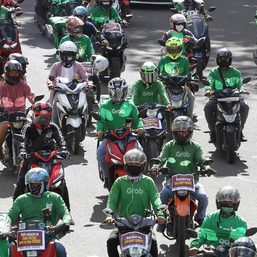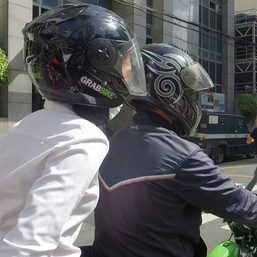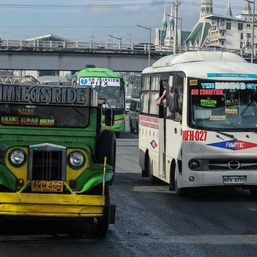SUMMARY
This is AI generated summarization, which may have errors. For context, always refer to the full article.

MANILA, Philippines – Caving in to pressure, President Ferdinand Marcos Jr. has granted a “final extension” for operators of public utility vehicles (PUVs) to consolidate.
Prior to the new April 30 deadline, more than 1,900 jeepney and UV Express routes risked being wiped out nationwide by February 1. Under a Land Transportation Franchising and Regulatory Board (LTFRB) memorandum circular, jeepneys that failed to consolidate before the deadline of December 31, 2023, had only until January 31 to ply certain routes, including those with low consolidation rates.
But there were also some routes where none of the jeepneys or UV Express units plying them formed a cooperative or corporation. Based on LTFRB data, 395 jeepney routes in Metro Manila have no consolidated entities, along with 108 routes for UV Express. Nationwide, the number of PUV routes without consolidated entities reaches 1,948. What happens to these routes?
Before the extension, this meant that legally, those routes were supposed to have no more trips by February 1 unless other consolidated PUVs were pulled in to serve them, or the PUVs originally under that route continued to ply them as “colorum” vehicles.
However, the government clarified now that unconsolidated PUVs will still be allowed to ply their routes by February in light of the extended deadline. The LTFRB, however, has yet to release an updated memorandum on how it will implement the extension.
Even with the new deadline granted, transportation officials were firm that operators must consolidate if they want to keep their routes. This extension will serve as a last chance for operators to consolidate into a cooperative or corporation.
Search this table below to see the consolidation status of your route as of December 31, 2023, if your route will still be in service by February 1. Take note that only routes labeled as having no consolidated entities are in danger of being wiped out.
Before the extension was announced, left-leaning critics of the PUV Modernization Program warned that the consolidation requirement will soon bring job losses and messy commutes.
“This reaffirms our fears of massive job losses and disruption of public transport after January 31 when unconsolidated jeeps and UVE will no longer be allowed to operate,” said Bagong Alyansang Makabayan president Renato Reyes in a statement on Saturday, January 20.
Transport group PISTON, which has co-led a series of protests against the program, also said a “mass transport disaster” awaited as “thousands” of drivers and operators could be displaced.
Using the data provided by the LTFRB, Rappler created a map visualizing the status of consolidation nationwide. Regions are shaded based on the number of jeepney or UV Express routes that failed to consolidate before December 31, 2023.
Looking closely at the data, Bicol is the region that has the most number of unconsolidated jeepney routes. Nearly 68% of all routes in Bicol, or 451 routes, have no consolidated jeepneys. In Metro Manila, more than 35% of jeepney routes have no consolidated jeepneys. Central Visayas, Caraga, and Soccsksargen are the only regions that do not have routes that failed to consolidate.
Still, the government insists that there will be no transportation crisis. According to the Department of Transportation (DOTr), consolidated cooperatives will be asked to operate on routes with unconsolidated jeepneys. In relation to this, drivers who will be displaced by consolidation could be absorbed by other cooperatives or corporations that will “badly need” them as they expand routes.
“We were assured by the cooperatives na sila po ay tatanggap ng mga drivers doon sa operators na hindi po nag-consolidate (that they will accept drivers from operators who were unable to consolidate),” said Office of Transportation Cooperatives Chairman Jesus Ferdinand Ortega on January 5.
The DOTr also views consolidation as an opportunity to “rationalize” routes, which means that it really doesn’t expect to keep all routes. Transportation Secretary Jaime Bautista said that based on the government’s study, achieving a 65% consolidation rate nationwide will be “sufficient” to carry the program forward. He explained that some routes are redundant, with shorter routes overlapping with longer ones.
“‘Yung mga naiwan, sa tingin namin, will be enough. And we will, siyempre, rationalize na ‘yung mga ruta. For example, merong isang ruta 'nyo na mahaba. May mga ruta in between. ‘Yun ‘yung mga unconsolidated, ‘yung in between, baka hindi na. Kaya, ‘yun ang mga tinitignan natin,” he said in an interview on January 5.
(Those that were left, in our view, will be enough. We will, of course, rationalize the routes. For example, there's one long route. There are routes in between. Those routes in between that were unconsolidated may be dropped. That's what we're looking at.)
In the meantime, the LTFRB also advised the public to turn to other modes of public transportation for their daily commute.
“There are still other modes of public transport in Metro Manila. We are talking of buses, other modes like taxis, TNVS (transport network vehicle services) that could also accommodate public demand,” said LTFRB NCR Regional Director Zona Tamayo in a press briefing last December 29.
The government has also gone on record numerous times to defend its controversial PUV Modernization Program, holding three press conferences about it in a week. In each one, officials underscored how the program will uplift drivers and operators and how consolidation is a necessary first step to upgrading to modern jeepneys. (READ: Anti-poor? How gov’t defends PUV modernization, why jeepney stakeholders oppose it) – Rappler.com
Add a comment
How does this make you feel?



![[Vantage Point] Bug and rodent infestation in NAIA: Why aren’t we surprised?](https://www.rappler.com/tachyon/2024/03/tl-bugs-and-rodents.jpg?resize=257%2C257&crop_strategy=attention)
![[Rappler’s Best] Bugged by the bug](https://www.rappler.com/tachyon/2024/03/bugged-by-the-bug.jpg?resize=257%2C257&crop=280px%2C0px%2C720px%2C720px)






There are no comments yet. Add your comment to start the conversation.